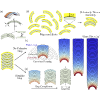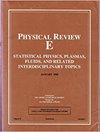曲率受挫胶体板的自限制堆叠:粒子内变形与粒子间变形的作用
IF 2.4
3区 物理与天体物理
Q1 Mathematics
引用次数: 0
摘要
在几何失谐装配中,局部亚基间的错位会传播到装配内部的应变梯度,从而引起反常的自限制装配热力学。在这里,我们利用理论和粗粒度模拟来研究最近开发的一类 "弯曲聚合体 "粒子,它们是灵活的壳状粒子,由于内聚堆栈中曲率变形的积累而表现出自限制装配。为了解决受挫组装中一个普遍但却鲜为人知的问题,我们引入了一个曲线组装模型,该模型既包含了粒子内部的形状变形,也包含了粒子间内聚间隙的顺应性,我们可以将这种效应归因于粒子间有限范围的吸引力。我们的研究表明,粒子内(弯曲弹性)与粒子间刚度之比不仅控制着自我限制机制,还控制着挫折在弯曲聚合体堆栈中传播的性质。我们发现,从小尺寸的均匀束缚、曲率聚焦堆叠到大尺寸的间隙打开、均匀弯曲堆叠的过渡,是由粒子间刚度与粒子内刚度的无量纲控制的。粒子间吸引力的有限范围决定了堆栈的内聚力范围是自限制的,这一预测与我们的粗粒胶体模型的数值研究结果非常吻合。这些预测为挫折粒子系统的实验实现提供了重要指导,这些挫折粒子系统的设计目的是在特别大的多粒子尺度上表现出自限制。本文章由计算机程序翻译,如有差异,请以英文原文为准。

Self-limiting stacks of curvature-frustrated colloidal plates: Roles of intraparticle versus interparticle deformations
In geometrically frustrated assemblies local intersubunit misfits propagate to intra-assembly strain gradients, giving rise to anomalous self-limiting assembly thermodynamics. Here we use theory and coarse-grained simulation to study a recently developed class of “curvamer” particles, flexible shell-like particles that exhibit self-limiting assembly due to the build up of curvature deformation in cohesive stacks. To address a generic, yet poorly understood aspect of frustrated assembly, we introduce a model of curvamer assembly that incorporates both intraparticle shape deformation as well as compliance of interparticle cohesive gaps, an effect we can attribute to a finite range of attraction between particles. We show that the ratio of intraparticle (bending elasticity) to interparticle stiffness not only controls the regimes of self-limitation but also the nature of frustration propagation through curvamer stacks. We find a transition from uniformly bound, curvature-focusing stacks at small size to gap opened, uniformly curved stacks at large size is controlled by a dimensionless measure of inter- versus intracurvamer stiffness. The finite range of interparticle attraction determines the range of cohesion in stacks that are self-limiting, a prediction which is in strong agreement with numerical studies of our coarse-grained colloidal model. These predictions provide critical guidance for experimental realizations of frustrated particle systems designed to exhibit self-limitation at especially large multiparticle scales.
求助全文
通过发布文献求助,成功后即可免费获取论文全文。
去求助
来源期刊

Physical review. E
物理-物理:流体与等离子体
CiteScore
4.60
自引率
16.70%
发文量
0
审稿时长
3.3 months
期刊介绍:
Physical Review E (PRE), broad and interdisciplinary in scope, focuses on collective phenomena of many-body systems, with statistical physics and nonlinear dynamics as the central themes of the journal. Physical Review E publishes recent developments in biological and soft matter physics including granular materials, colloids, complex fluids, liquid crystals, and polymers. The journal covers fluid dynamics and plasma physics and includes sections on computational and interdisciplinary physics, for example, complex networks.
 求助内容:
求助内容: 应助结果提醒方式:
应助结果提醒方式:


